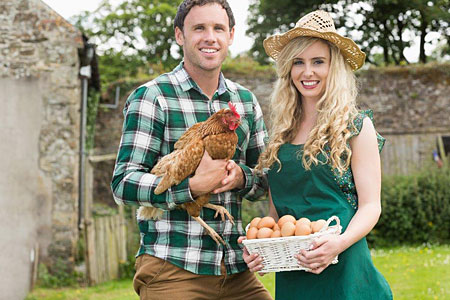
Chicken keepers in the United States are a diverse bunch in such things as where they live, how many chickens they keep, and what they feed their flock. A paper published in Poultry Science offers some interesting insights about who, exactly, chicken keepers are.
Urban or Rural
Backyard chicken keepers in the United States are approximately equally divided in where they live. Some 38.4% are rural, 31.5% urban, and 30.1% suburban. Interestingly, only 4.1% are involved in agriculture per se.
Reasons for Chickens
The major reasons people keep backyard chickens are: to get eggs and/or meat for home use (95.2%), to have gardening “partners” for pest control and manure fertilizer (62.8%), and as pets (57.4%).
Chickens Rule
Most people who keep poultry prefer chicken breeds that lay eggs with colored shells — such as Rhode Island Red, Plymouth Rock, Ameraucana, Orpington, and Wyandotte. Only about 15% keep other poultry besides chickens, more so in rural areas (24%). However, a few suburban (11%) and urban (8%) keepers also have mixed flocks. The most common other species are ducks (55%) and turkeys (29%).
Down with Roosters
Most flocks consist predominantly of hens, with 68% having no rooster at all. Of those that do keep a rooster, 15% have one and 17% have more than one. As you might expect, roosters are more common in rural areas than in suburban or urban environments.
Flock Size
Although USDA defines a backyard flock as consisting of less than 1,000 poultry of all species, most people keep far fewer that that. Flock size ranges from 1 to 5 birds (43.5%), 6 to 10 birds (28.3%), and 11 to 20 birds (15.7%). Only 12.5% keep more than 20 chickens and, again as you might expect, they are mostly rural residents. To decide how big a flock is right for you, check out these helpful blogs:
How Many Chickens Make a Flock?
The Best Number of Chickens for Your Flock
Housing
Almost all backyard flocks are housed in a stationary coop and have either an enclosed run (35.5%), free-range access during the daytime (49.4%), or both (7.7%). Surprisingly, given the number of publications related to mobile and portable housing, few people use them. Also rare are cages and no housing at all.
Feeding
Most flocks (75.4%) are fed a mixed ration of purchased feed and kitchen scraps. Some chicken keepers (21.2%) feed only a ration purchased at the feed store, while others (2.5%) feed a grain-based homemade ration. Few flocks (0.5%) are fed nothing at all, unrealistically being expected to forage for themselves. Fewer still (0.4%) suffer a poor diet consisting only of kitchen scraps.
Disease
Most flocks (58.6%) experience no health-related conditions. Among those with health issues, the most common ones are external parasites such as lice and mites (11.4%), “other” (10.9%), diarrhea (10.6%), and injuries (8.1%). In the “other” category, the most likely conditions are prolapsed vent and sour crop. However, death due to any disease is uncommon.
Predators
Almost half of flock owners (49%) feel that minimizing predation is the biggest challenge to raising chickens. The most common precautions taken to prevent predation are to erect fences (82%), close birds inside at night (78.7%), and use an overhead run cover (52.4%). About 20% have guard animals — primarily dogs, but also donkeys, geese, and guinea fowl.
Learning More
When backyard flock owners seek more information about chicken keeping, 87% turn to the internet, 62% read books and magazines, and 40% ask at the feed store. The most common searches are for how to detect health problems (64%) and how to treat them (66%). If you plan to search for health care info online, first check out Online Sources for Reliable Information on Poultry Health.
And that’s today’s news from the Cackle Coop.
Gail Damerow has written several books about keeping poultry, many of them available from the Cackle Bookstore.

